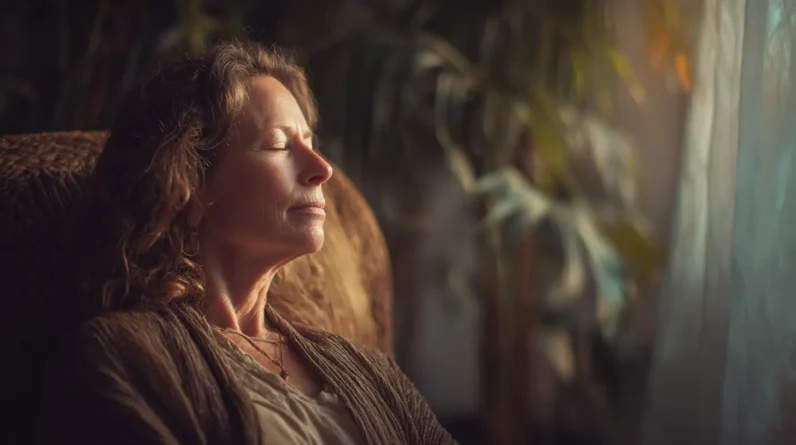
Guided imagery is a powerful tool we can use to enhance our mental resilience. By engaging our imagination and senses, we create vivid mental experiences that activate brain areas linked to perception and emotion. This practice helps reduce stress, improve emotional regulation, and boost our overall mood. We can start by finding a quiet space, incorporating deep breathing, and visualizing positive scenarios for 5 to 60 minutes. Regular practice strengthens our coping abilities over time, making us better equipped to handle life’s challenges. By personalizing our imagery and addressing common hurdles, we’ll reveal the full potential of this accessible mind-body intervention.
Understanding Guided Imagery Fundamentals
Guided imagery stands out as a powerful mind-body intervention that taps into our brain’s remarkable ability to respond to imagined scenarios as if they were real. This relaxation technique engages our senses and creates vivid mental experiences, activating brain areas associated with sensory perception and emotion. By incorporating positive mental imagery and sensory details, we can effectively transform negative states into positive ones, enhancing our emotional regulation and overall well-being.
As a stress management technique, guided imagery requires minimal resources, making it an accessible practice for daily life. Regular use of this visualization method can lead to long-term changes in our stress response patterns, improving our mental resilience and increasing our ability to cope with stressors. By harnessing the power of our imagination, we can reduce stress and cultivate a calmer, more controlled state of mind.
Benefits for Mental Resilience
Harnessing the power of guided imagery yields significant benefits for mental resilience, equipping individuals with valuable tools to navigate life’s challenges. This powerful relaxation technique activates the parasympathetic nervous system, promoting stress relief and enhancing emotional regulation. Regular practice can lead to long-term changes in stress response patterns, fostering resilience through improved coping mechanisms.
Key benefits of guided imagery for mental resilience include:
– Reduced stress and anxiety
– Enhanced emotional regulation skills
– Improved self-efficacy and overall mood
Techniques to Practice Guided Imagery
With an understanding of guided imagery’s benefits for mental resilience, let’s explore effective techniques to incorporate this practice into daily life. To practice guided imagery effectively, we must first find a quiet space and engage in deep diaphragmatic breathing to initiate relaxation. Visualization can help create a serene environment by incorporating all five senses, enhancing the immersive experience. Regular practice is essential; aim for sessions lasting 5 to 60 minutes to deepen the relaxation response and improve mental resilience over time.
Utilizing audio recordings or guided sessions can provide structure and facilitate deeper engagement. Personalizing imagery to reflect individual goals greatly enhances its effectiveness, making the practice more meaningful. By consistently applying these guided imagery techniques, we can reduce stress and cultivate positive imagery, ultimately strengthening our mental resilience in the face of life’s challenges.
Overcoming Common Challenges
While practicing guided imagery can be transformative, many individuals encounter obstacles that may hinder their progress. To overcome these challenges and enhance mental resilience, we can employ several strategies:
– Utilize deep breathing techniques before visualization to improve focus
– Incorporate vivid sensory details to increase engagement
– Seek professional support or use guided audio recordings for a structured approach
Scientific evidence supports the effectiveness of guided imagery in reducing anxiety and improving emotional well-being. By addressing skepticism with this data, we can foster confidence in the practice. Regular, consistent engagement strengthens our ability to cope with stressors over time. As we develop our visualization experience, we’ll notice a shift towards more positive emotional states. Remember, initial difficulties are common, but with persistence and the right techniques, we can harness the full potential of guided imagery for mental resilience.
Integrating Into Daily Life
Having addressed common challenges, we now turn our attention to making guided imagery a seamless part of our daily routines. We can easily integrate this practice of visualization into our lives by utilizing downtime moments, such as commutes or breaks. Engaging in guided imagery for just 5 to 60 minutes per session yields significant stress reduction benefits, enhancing our emotional resilience over time. Incorporating audio recordings or mindfulness apps provides convenient access to these techniques, ensuring consistency and effectiveness.
By regularly practicing guided imagery, we reinforce positive mental patterns, creating a buffer against stressors and improving our coping strategies for daily challenges. To deepen the impact, we can explore various sensory experiences during our sessions, such as incorporating soothing music or aromas. This multifaceted approach promotes calmness, clarity, and overall mental resilience in our daily lives.
Conclusion
We’ve explored how guided imagery can greatly boost our mental resilience. Studies show that regular practice can reduce stress levels by up to 56%. By understanding the fundamentals, recognizing the benefits, mastering techniques, overcoming challenges, and integrating it into our daily lives, we’re equipping ourselves with a powerful tool for mental well-being. As we continue to face life’s uncertainties, let’s embrace guided imagery as a scientifically-backed method to enhance our psychological fortitude and overall quality of life.






